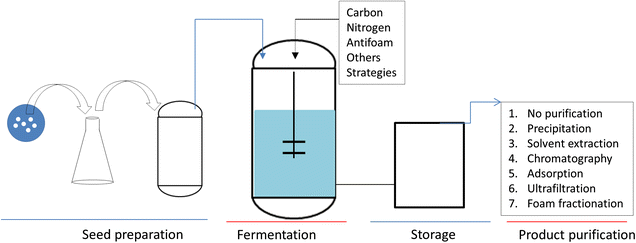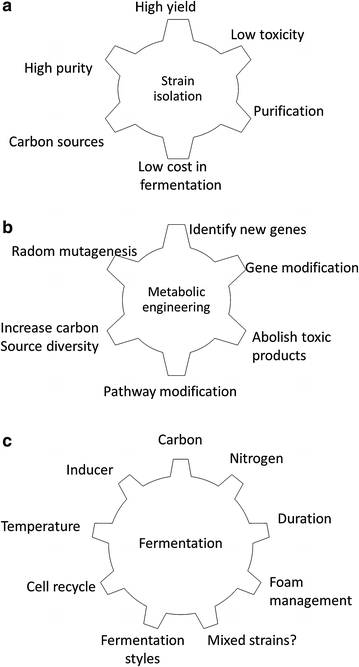Microbial production of rhamnolipids: opportunities, challenges and strategies
- PMID: 28779757
- PMCID: PMC5544971
- DOI: 10.1186/s12934-017-0753-2
Microbial production of rhamnolipids: opportunities, challenges and strategies
Abstract
Rhamnolipids are a class of biosurfactants which contain rhamnose as the sugar moiety linked to β-hydroxylated fatty acid chains. Rhamnolipids can be widely applied in many industries including petroleum, food, agriculture and bioremediation etc. Pseudomonas aeruginosa is still the most competent producer of rhamnolipids, but its pathogenicity may cause safety and health concerns during large-scale production and applications. Therefore, extensive studies have been carried out to explore safe and economical methods to produce rhamnolipids. Various metabolic engineering efforts have also been applied to either P. aeruginosa for improving its rhamnolipid production and diminishing its pathogenicity, or to other non-pathogenic strains by introducing the key genes for safe production of rhamnolipids. The three key enzymes for rhamnolipid biosynthesis, RhlA, RhlB and RhlC, are found almost exclusively in Pseudomonas sp. and Burkholderia sp., but have been successfully expressed in several non-pathogenic host bacteria to produce rhamnolipids in large scales. The composition of mono- and di-rhamnolipids can also be modified through altering the expression levels of RhlB and RhlC. In addition, cell-free rhamnolipid synthesis by using the key enzymes and precursors from non-pathogenic sources is thought to not only eliminate pathogenic effects and simplify the downstream purification processes, but also to circumvent the complexity of quorum sensing system that regulates rhamnolipid biosynthesis. The pathogenicity of P. aeruginosa can also be reduced or eliminated through in vivo or in vitro enzymatic degradation of the toxins such as pyocyanin during rhamnolipid production. The rhamnolipid production cost can also be significantly reduced if rhamnolipid purification step can be bypassed, such as utilizing the fermentation broth or the rhamnolipid-producing strains directly in the industrial applications of rhamnolipids.
Keywords: Application; Metabolic engineering; Pseudomonas, fermentation; Rhamnolipids.
Figures



Similar articles
-
Novel insights into biosynthesis and uptake of rhamnolipids and their precursors.Appl Microbiol Biotechnol. 2017 Apr;101(7):2865-2878. doi: 10.1007/s00253-016-8041-3. Epub 2016 Dec 17. Appl Microbiol Biotechnol. 2017. PMID: 27988798 Free PMC article.
-
Heterologous production of long-chain rhamnolipids from Burkholderia glumae in Pseudomonas putida-a step forward to tailor-made rhamnolipids.Appl Microbiol Biotechnol. 2018 Feb;102(3):1229-1239. doi: 10.1007/s00253-017-8702-x. Epub 2017 Dec 20. Appl Microbiol Biotechnol. 2018. PMID: 29264775
-
Synthesis of di-rhamnolipids by the avirulent, mono-rhamnolipid producing strain Pseudomonas aeruginosa ATCC 9027.Biotechnol Lett. 2024 Dec;46(6):1163-1170. doi: 10.1007/s10529-024-03527-7. Epub 2024 Sep 3. Biotechnol Lett. 2024. PMID: 39225887 Free PMC article.
-
Heterologous Rhamnolipid Biosynthesis: Advantages, Challenges, and the Opportunity to Produce Tailor-Made Rhamnolipids.Front Bioeng Biotechnol. 2020 Oct 22;8:594010. doi: 10.3389/fbioe.2020.594010. eCollection 2020. Front Bioeng Biotechnol. 2020. PMID: 33195161 Free PMC article. Review.
-
Rhamnolipids--next generation surfactants?J Biotechnol. 2012 Dec 31;162(4):366-80. doi: 10.1016/j.jbiotec.2012.05.022. Epub 2012 Jun 20. J Biotechnol. 2012. PMID: 22728388 Review.
Cited by
-
Sustainable Management of Tetranychus urticae and Trialeurodes vaporariorum on Tomato and Cucumber Plants Using Rhamnolipids and Essential Oil-Based Biocontrol Agents.Insects. 2024 Sep 20;15(9):720. doi: 10.3390/insects15090720. Insects. 2024. PMID: 39336688 Free PMC article.
-
In-Depth Genomic and Phenotypic Characterization of the Antarctic Psychrotolerant Strain Pseudomonas sp. MPC6 Reveals Unique Metabolic Features, Plasticity, and Biotechnological Potential.Front Microbiol. 2019 May 24;10:1154. doi: 10.3389/fmicb.2019.01154. eCollection 2019. Front Microbiol. 2019. PMID: 31178851 Free PMC article.
-
Biosurfactants: Properties and Applications in Drug Delivery, Biotechnology and Ecotoxicology.Bioengineering (Basel). 2021 Aug 13;8(8):115. doi: 10.3390/bioengineering8080115. Bioengineering (Basel). 2021. PMID: 34436118 Free PMC article. Review.
-
Identification of Pseudomonas aeruginosa exopolysaccharide Psl in biofilms using 3D OrbiSIMS.Biointerphases. 2023 May 1;18(3):031007. doi: 10.1116/6.0002604. Biointerphases. 2023. PMID: 37255378 Free PMC article.
-
Effects of Biosurfactants on Enzymatic Saccharification and Fermentation of Pretreated Softwood.Molecules. 2020 Aug 5;25(16):3559. doi: 10.3390/molecules25163559. Molecules. 2020. PMID: 32764287 Free PMC article.
References
Publication types
MeSH terms
Substances
LinkOut - more resources
Full Text Sources
Other Literature Sources
Molecular Biology Databases

